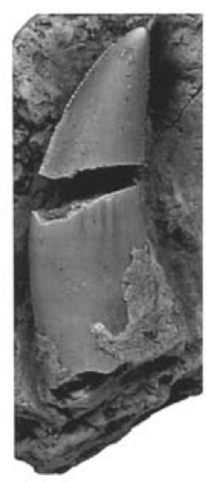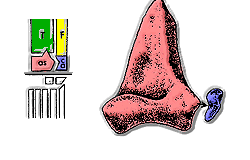|
Avalonia (dinosaur)
''Avalonianus'' is a highly dubious and possibly invalid genus of archosaur from the Late Triassic of England. It was first described in 1898 by Harry Seeley with the name ''Avalonia'',H. G. Seeley. 1898. On large terrestrial saurians from the Rhaetic Beds of Wedmore Hill, described as ''Avalonia sanfordi'' and ''Picrodon herveyi''. Geological Magazine, decade 4 5:1-6 but that name was preoccupied (Walcott, 1889), so Oskar Kuhn renamed it in 1961, albeit with no epithet (although Seeley added the epithet ''sanfordi'' in 1898). It was thought to be a prosauropod, but later analysis revealed it was actually a chimera, with the original teeth coming from a non-dinosaurian ornithosuchian (or possibly an early theropod Theropoda (; ), whose members are known as theropods, is a dinosaur clade that is characterized by hollow bones and three toes and claws on each limb. Theropods are generally classed as a group of saurischian dinosaurs. They were ancestrally c ...), and later-refer ... [...More Info...] [...Related Items...] OR: [Wikipedia] [Google] [Baidu] |
Late Triassic
The Late Triassic is the third and final epoch (geology), epoch of the Triassic geologic time scale, Period in the geologic time scale, spanning the time between annum, Ma and Ma (million years ago). It is preceded by the Middle Triassic Epoch and followed by the Early Jurassic Epoch. The corresponding series (stratigraphy), series of rock beds is known as the Upper Triassic. The Late Triassic is divided into the Carnian, Norian and Rhaetian Geologic time scale, Ages. Many of the first dinosaurs evolved during the Late Triassic, including ''Plateosaurus'', ''Coelophysis'', and ''Eoraptor''. The Triassic–Jurassic extinction event began during this epoch and is one of the five major mass extinction events of the Earth. Etymology The Triassic was named in 1834 by Friedrich August von Namoh, Friedrich von Alberti, after a succession of three distinct rock layers (Greek meaning 'triad') that are widespread in southern Germany: the lower Buntsandstein (colourful sandstone'')'', t ... [...More Info...] [...Related Items...] OR: [Wikipedia] [Google] [Baidu] |
Prosauropod
Sauropodomorpha ( ; from Greek, meaning "lizard-footed forms") is an extinct clade of long-necked, herbivorous, saurischian dinosaurs that includes the sauropods and their ancestral relatives. Sauropods generally grew to very large sizes, had long necks and tails, were quadrupedal, and became the largest animals to ever walk the Earth. The ''prosauropods,'' which preceded the sauropods, were smaller and were often able to walk on two legs. The sauropodomorphs were the dominant terrestrial herbivores throughout much of the Mesozoic Era, from their origins in the Late Triassic (approximately 230 Ma) until their decline and extinction at the end of the Cretaceous. Description Sauropodomorphs were adapted to browsing higher than any other contemporary herbivore, giving them access to high tree foliage. This feeding strategy is supported by many of their defining characteristics, such as: a light, tiny skull on the end of a long neck (with ten or more elongated cervical vertebrae) a ... [...More Info...] [...Related Items...] OR: [Wikipedia] [Google] [Baidu] |
Late Triassic Reptiles Of Europe
Late may refer to: * LATE, an acronym which could stand for: ** Limbic-predominant age-related TDP-43 encephalopathy, a proposed form of dementia ** Local-authority trading enterprise, a New Zealand business law ** Local average treatment effect, a concept in econometrics Music * ''Late'' (album), a 2000 album by The 77s * Late!, a pseudonym used by Dave Grohl on his ''Pocketwatch'' album * Late (rapper), an underground rapper from Wolverhampton * "Late" (song), a song by Blue Angel * "Late", a song by Kanye West from ''Late Registration'' Other * Late (Tonga), an uninhabited volcanic island southwest of Vavau in the kingdom of Tonga * "Late" (''The Handmaid's Tale''), a television episode * LaTe, Oy Laivateollisuus Ab, a defunct shipbuilding company * Late may refer to a person who is Dead See also * * * ''Lates'', a genus of fish in the lates perch family * Later (other) * Tardiness * Tardiness (scheduling) In scheduling, tardiness is a measure of a delay in exe ... [...More Info...] [...Related Items...] OR: [Wikipedia] [Google] [Baidu] |
Prehistoric Archosaurs
Prehistory, also known as pre-literary history, is the period of human history between the use of the first stone tools by hominins 3.3 million years ago and the beginning of recorded history with the invention of writing systems. The use of symbols, marks, and images appears very early among humans, but the earliest known writing systems appeared 5000 years ago. It took thousands of years for writing systems to be widely adopted, with writing spreading to almost all cultures by the 19th century. The end of prehistory therefore came at very different times in different places, and the term is less often used in discussing societies where prehistory ended relatively recently. In the early Bronze Age, Sumer in Mesopotamia, the Indus Valley Civilisation, and ancient Egypt were the first civilizations to develop their own scripts and to keep historical records, with their neighbors following. Most other civilizations reached the end of prehistory during the following Iron Age. T ... [...More Info...] [...Related Items...] OR: [Wikipedia] [Google] [Baidu] |
Theropod
Theropoda (; ), whose members are known as theropods, is a dinosaur clade that is characterized by hollow bones and three toes and claws on each limb. Theropods are generally classed as a group of saurischian dinosaurs. They were ancestrally carnivorous, although a number of theropod groups evolved to become herbivores and omnivores. Theropods first appeared during the Carnian age of the late Triassic period 231.4 million years ago ( Ma) and included all the large terrestrial carnivores from the Early Jurassic until at least the close of the Cretaceous, about 66 Ma. In the Jurassic, birds evolved from small specialized coelurosaurian theropods, and are today represented by about 10,500 living species. Biology Diet and teeth Theropods exhibit a wide range of diets, from insectivores to herbivores and carnivores. Strict carnivory has always been considered the ancestral diet for theropods as a group, and a wider variety of diets was historically considered a characteri ... [...More Info...] [...Related Items...] OR: [Wikipedia] [Google] [Baidu] |
Ornithosuchian
Avemetatarsalia (meaning "bird metatarsals") is a clade of diapsid reptiles containing all archosaurs more closely related to birds than to crocodilians. The two most successful groups of avemetatarsalians were the dinosaurs and pterosaurs. Dinosaurs were the largest terrestrial animals for much of the Mesozoic Era, and one group of small feathered dinosaurs (Aves, i.e. birds) has survived up to the present day. Pterosaurs were the first flying vertebrates and persisted through the Mesozoic before dying out at the Cretaceous-Paleogene (K-Pg) extinction event. Both dinosaurs and pterosaurs appeared in the Triassic Period, shortly after avemetatarsalians as a whole. The name Avemetatarsalia was first established by British palaeontologist Michael Benton in 1999. An alternate name is Panaves, or "all birds", in reference to its definition containing all animals, living or extinct, which are more closely related to birds than to crocodilians. Although dinosaurs and pterosaurs were th ... [...More Info...] [...Related Items...] OR: [Wikipedia] [Google] [Baidu] |
Chimera (paleontology)
In paleontology, a chimera is a fossil that was reconstructed with elements coming from more than a single species or genus of animal. In other words they are mistakes or sometimes hoaxes made by paleontologists, putting together parts that do not come from the same organism. A now classic example of chimera is ''Protoavis''. List of paleontological chimeras * Archaeoraptor * ''Dalianraptor''? * ''Lametasaurus''? * ''Protoavis'' * Piltdown Man * ''Ultrasauros'' * ''Ornithopsis hulkei'' * Teihivenator * ''Dakotaraptor''? * ''Avalonianus'' * ''Kootenichela''? * ''Polacanthoides''?Nopcsa, F. (1928), "Palaeontological notes on reptiles." Geologica Hungarica, Series Palaeontologica, tomus, 1, -Pasc. 1, p. 1-84 References Paleontological chimeras, {{paleo-stub ... [...More Info...] [...Related Items...] OR: [Wikipedia] [Google] [Baidu] |
Oskar Kuhn
Oskar Kuhn (7 March 1908, Munich – 1990) was a German palaeontologist. Life and career Kuhn was educated in Dinkelsbühl and Bamberg and then studied natural science, specialising in geology and paleontology, at the University of Munich, from which he received his D. Phil. in 1932. He worked in the University of Munich Geological Institute, among other things on the ''Fossilium Catalogus'' (Catalogue of Fossils), and then in 1938 on a stipend from the Deutsche Forschungsgemeinschaft, moved to the University of Halle, where he worked on the Geiseltal fossils. In 1939 he achieved his Habilitation with a thesis on the Halberstadt Keuper fauna, and in 1940 was named Privatdozent in geology and paleontology. Informed by his Catholic religion, Kuhn was an exponent of idealistic morphology: he viewed evolution as operating only within predetermined morphological classes. In 1943 he declared, "The theory of descent has collapsed." After a political conflict with his mentor, Johan ... [...More Info...] [...Related Items...] OR: [Wikipedia] [Google] [Baidu] |
Harry Seeley
Harry Govier Seeley (18 February 1839 – 8 January 1909) was a British paleontologist. Early life Seeley was born in London on 18 February 1839, the second son of Richard Hovill Seeley, a goldsmith, and his second wife Mary Govier. When his father was declared bankrupt, Seeley was sent to live with a family of piano makers. Between the ages of eleven and fourteen, he went to a day school and then spent the next two years learning to make pianos. He also attended lectures at the Royal School of Mines by Thomas Henry Huxley, Edward Forbes, and other notable scientists. In 1855, with the support of his uncle, Seeley began to study law but shortly gave it up to pursue a career as an actuary. In the late 1850s, he studied English and mathematics at the Working Men's College and served as a secretary for the college's museum. He also worked in the library of the British Museum, where Samuel Pickworth Woodward encouraged him to study geology. In 1859, Seeley began studies at Sidney Su ... [...More Info...] [...Related Items...] OR: [Wikipedia] [Google] [Baidu] |
England
England is a country that is part of the United Kingdom. It shares land borders with Wales to its west and Scotland to its north. The Irish Sea lies northwest and the Celtic Sea to the southwest. It is separated from continental Europe by the North Sea to the east and the English Channel to the south. The country covers five-eighths of the island of Great Britain, which lies in the North Atlantic, and includes over 100 smaller islands, such as the Isles of Scilly and the Isle of Wight. The area now called England was first inhabited by modern humans during the Upper Paleolithic period, but takes its name from the Angles, a Germanic tribe deriving its name from the Anglia peninsula, who settled during the 5th and 6th centuries. England became a unified state in the 10th century and has had a significant cultural and legal impact on the wider world since the Age of Discovery, which began during the 15th century. The English language, the Anglican Church, and Engli ... [...More Info...] [...Related Items...] OR: [Wikipedia] [Google] [Baidu] |
Archosaur
Archosauria () is a clade of diapsids, with birds and crocodilians as the only living representatives. Archosaurs are broadly classified as reptiles, in the cladistic sense of the term which includes birds. Extinct archosaurs include non-avian dinosaurs, pterosaurs, and extinct relatives of crocodilians. Modern paleontologists define Archosauria as a crown group that includes the most recent common ancestor of living birds and crocodilians, and all of its descendants. The base of Archosauria splits into two clades: Pseudosuchia, which includes crocodilians and their extinct relatives, and Avemetatarsalia, which includes birds and their extinct relatives (such as non-avian dinosaurs and pterosaurs). Older definitions of the group Archosauria rely on shared morphological characteristics, such as an antorbital fenestra in the skull, serrated teeth, and an upright stance. Some extinct reptiles, such as proterosuchids and euparkeriids, possessed these features yet originated pri ... [...More Info...] [...Related Items...] OR: [Wikipedia] [Google] [Baidu] |






